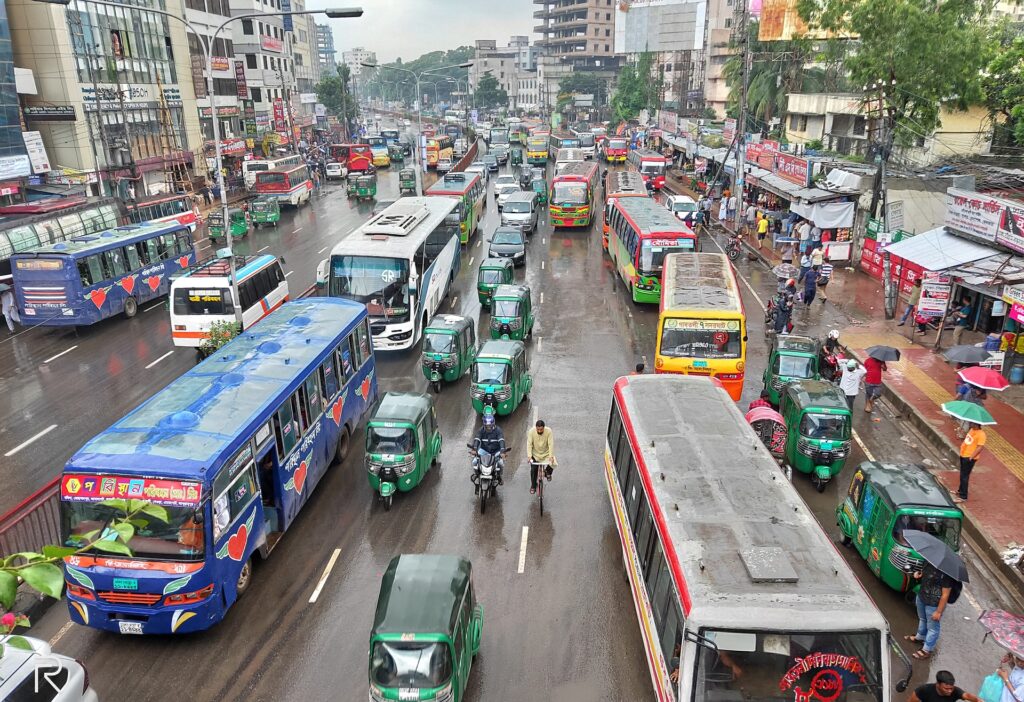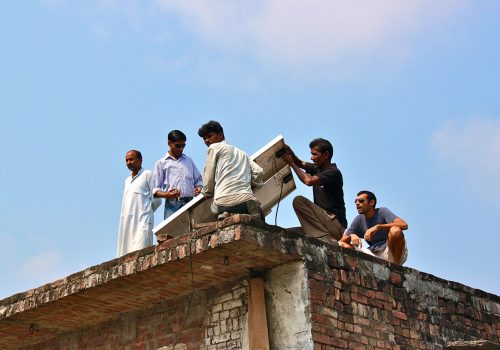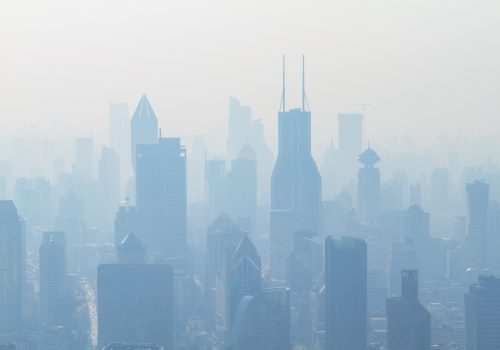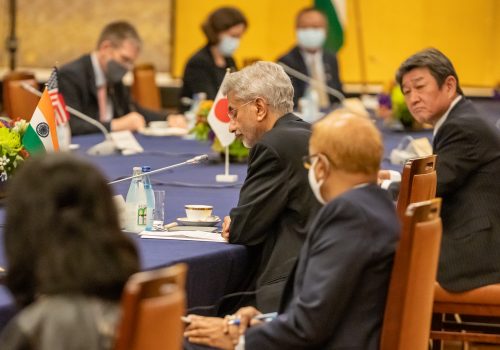Bangladesh is grappling with a severe air quality crisis. Recent reports highlight pollution’s impact on the nation’s health, economy, and environment. Bangladesh urgently needs to balance growth, sustainability, and energy access to enhance the well-being of its population. But the country faces profound challenges in moving toward a safer and more equitable energy system.
STAY CONNECTED
Sign up for PowerPlay, the Atlantic Council’s bimonthly newsletter keeping you up to date on all facets of the energy transition.
Bangladesh’s air quality crisis
The air quality index (AQI) measures air pollution through levels of PM2.5, fine particulate matter small enough to penetrate the lungs and enter the bloodstream. This past decade, PM2.5 concentration in Bangladesh’s capital, Dhaka, came in at a yearly average of 77.1 micrograms per cubic meter (μg/m³), more than eight times higher than the US Environmental Protection Agency’s health-based PM2.5 standard of 9.0 μg/m³ per year.
Bangladesh’s alarming AQI has many causes, including vehicle emissions, industrial discharges, and the widespread use of kilns to make bricks. These are all exacerbated by the absence of stringent environmental regulations and enforcement.
This extreme level of air pollution exacts a severe human toll. Particulate pollution has reduced the average life expectancy in Bangladesh by 6.9 years. By contrast, the next-biggest health hazard in the country—tobacco use—reduces life expectancy by 1.6 years, while child and maternal malnutrition in Bangladesh are responsible for a 1.4-year decrease. Pollution in Bangladesh not only has a dire immediate health impact; it poses negative long-term consequences on the well-being and productivity of its population.
Rising incomes, rising emissions
Bangladesh’s level of carbon emissions are also rising, tied to increasing levels of development fueled by hydrocarbons. Between 2010 and 2022, Bangladesh’s annual per capita income rose by three-and-a-half times to reach nearly $2,700 in real terms. Over the same period, Bangladesh’s consumption of oil and coal rose by factors of three and six, respectively. Natural gas consumption also rose by 52 percent.
While greater economic growth has improved living standards in Bangladesh, air quality has worsened. A World Bank study found that average annual PM2.5 concentration levels in Dhaka rose from 84 μg/m³ in 2013 to 106 μg/m³ in 2021.
Bangladesh’s growing use of fossil fuels has not only worsened air pollution, it has also contributed to climate impacts, which will increasingly produce negative economic effects. The United Nations Intergovernmental Panel on Climate Change says Bangladesh could lose 2 to 9 percent of its GDP from more frequent natural disasters like tropical cyclones and severe flooding.
It’s important to note, however, that Bangladesh’s use of coal pales in comparison to other regional actors. According to data from the Energy Institute, China’s consumption of commercial solid coal fuels exceeded Bangladesh’s by more than 325 times in 2023. So, while the world should seek to mitigate Bangladesh’s coal consumption, the country only contributes about 0.4 percent of all world emissions, even as China accounted for about 27 percent of greenhouse gas emissions in 2021, according to Climate Watch.
Nevertheless, if Bangladesh’s use and import of coal remains on its current trajectory, 2024 is poised to break national emissions records—and, more significantly—degrade its air quality and economic goals. Importantly, Bangladesh’s coal use could harm its export abilities as the European Union and other jurisdictions impose carbon border adjustments.
Bangladesh’s difficult transition to clean energy
Bangladesh’s poor air quality is disproportionately large compared to its overall carbon footprint. The country contributes less than 1 percent of global carbon emissions, yet its cities have some of the worst AQI scores in the world. Fifty-nine percent of the country’s energy derives from natural gas, 31 percent from oil, and 10 percent from coal. Renewables are a negligible part of Bangladesh’s energy mix, while coal use has ticked up sharply in both absolute and proportional terms.
Coal-versus-gas competition has great relevance for Bangladesh’s air quality. While natural gas emits carbon dioxide, it produces far fewer particulates than coal, with some studies showing that swapping coal for gas can reduce harmful emissions of sulfur dioxide by more than 90 percent, and of nitric oxide and nitrogen dioxide (NOX) by more than 60 percent.
Coal-to-gas switching is a quick and relatively easy fix for Bangladesh’s air quality concerns, given the country’s daunting challenges in switching to clean energy. Bangladesh’s solar and wind resources are limited, and it has weak hydropower potential. The country suffers an absence of summertime breezes, reducing wind’s usefulness in meeting peak demand during the hottest months.
The promise of nuclear energy
Given its constrained supply of indigenous renewables, Bangladesh is building two new nuclear power plants, for which Russia, China, and South Korea all provided bids. In 2009, Russia’s proposal was accepted. Bangladesh’s first reactor, which began construction in 2017, is set to begin operation this year.
While nuclear energy produces no emissions or pollutants, Bangladesh’s pursuit of the technology has not been cheap. Russia’s Rosatom is providing technical assistance, but Bangladesh is responsible for financing, for which it received a Russian loan. The Rosatom-led Rooppur project will cost $12.65 billion and is set to have a total capacity of 2.4 gigawatts. While nuclear energy is useful for decarbonization and improving air quality, expanding it further in the near term will prove difficult for Bangladesh. Capital financing costs have risen since Russia’s full-scale invasion of Ukraine, while tie-ups with Rosatom are potentially fraught. Some US legislators have called for sanctions on the state-owned Russian nuclear power giant, although experts generally believe these measures would disrupt Western markets while providing few geopolitical benefits.
How Bangladesh can improve its air quality
A nearer-term and more affordable option for reducing air pollution is liquefied natural gas (LNG). LNG is a fossil fuel, but it burns cleaner than coal and oil, which can help improve air quality.
Other measures to improve Bangladesh’s air quality could target vehicles, a major source of air pollutants. Bangladesh should look to models such as Mexico City’s ‘hoy no circula’ or Beijing’s odd and even days to limit vehicle pollution.
In Mexico City, the last number of a vehicle’s license plate determines which days it can be driven, with only the lowest-emission vehicles allowed to operate seven days a week. In Beijing, a similar program dates back to 2008, when China hosted the Summer Olympics. Beijing’s restrictions limit which weekdays cars with license plates ending in certain digits are allowed on the road.
These measures come at a significant economic cost, which may be too high given Bangladesh’s lower level of economic development compared to Mexico and China. But Bangladesh’s cities may consider such tradeoffs as acceptable given the severity of the country’s air quality crisis.
Over the longer term, Bangladesh can access cleaner electricity and lower its air pollution by integrating its grid with other hydropower-rich countries in the region. In January 2024, India concluded an agreement with Nepal to import 10,000 megawatts of hydropower from the Himalayan country, showing that cross-border electricity deals are possible in the region.
While deeper integration of regional electricity markets will require substantially more political trust than exists today, cooperation is necessary to meet Bangladesh’s energy access and air quality needs.
Bangladesh’s air quality trilemma
There are no easy ways to mitigate Bangladesh’s air quality crisis. Bangladesh has little renewable energy potential and faces difficulties in expanding nuclear energy or adopting vehicular emissions programs given the country’s limited financial resources. Moreover, Bangladesh suffers from substantial energy poverty, making improved energy access a top priority.
It is extremely difficult to balance these concerns, particularly in the short term. But in the longer term, trade in low-emission fuels and clean electricity can help Bangladesh resolve its trilemma of ensuring clean air, economic growth, and sustainable energy access.
Joe Webster is a senior fellow at the Atlantic Council Global Energy Center.
Natalie Sinha is a former young global professional at the Atlantic Council Global Energy Center.
Sarah Meadows is a former young global professional at the Atlantic Council Global Energy Center.
This article reflects the authors’ personal opinions.
MEET THE AUTHOR
RELATED CONTENT
OUR WORK

The Global Energy Center develops and promotes pragmatic and nonpartisan policy solutions designed to advance global energy security, enhance economic opportunity, and accelerate pathways to net-zero emissions.
Image: A busy road in Dhaka, Bangladesh. (Alit22, Pixabay, Pixabay Content License) https://pixabay.com/service/license-summary/)





